Are spam registrations becoming a problem for your affiliate program? Google’s reCAPTCHA is a powerful tool for preventing spam and fraudulent activity on your affiliate registration forms. By integrating reCAPTCHA with AffiliateWP, you can protect your forms from automated bots while maintaining a smooth experience for legitimate users.
This guide will walk you through setting up Google reCAPTCHA in AffiliateWP and ensuring it works correctly on your registration forms.
Configuring reCAPTCHA Type
To begin, log in to your WordPress site and navigate to AffiliateWP » Settings » Affiliates. Scroll down to the Affiliate Registration & Login Security section. Under the CAPTCHA options, select Google reCAPTCHA.
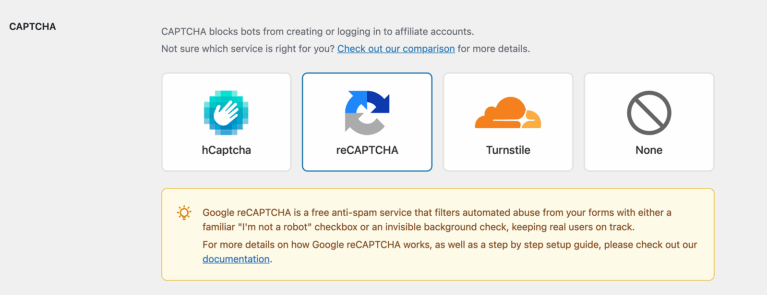
Once selected, you’ll be able to choose the type of reCAPTCHA you want to use:
- reCAPTCHA v2: Adds a checkbox labeled “I’m not a robot” to your registration form.
- reCAPTCHA v3: Runs invisibly in the background, using behavior analysis to detect spam.
Choose the option that works best for your site.
Generating reCAPTCHA Keys in Google
Once you’ve chosen a reCAPTCHA type, visit the Google reCAPTCHA site to generate the necessary keys.
- Log in with your Google account and click the + Add button to register your site.
- Select the reCAPTCHA type (v2 or v3) that matches your AffiliateWP settings.
- Add your domain(s). Ensure all variations, such as
www.yourdomain.comandyourdomain.com, are included. - Agree to the terms of service and click Submit.
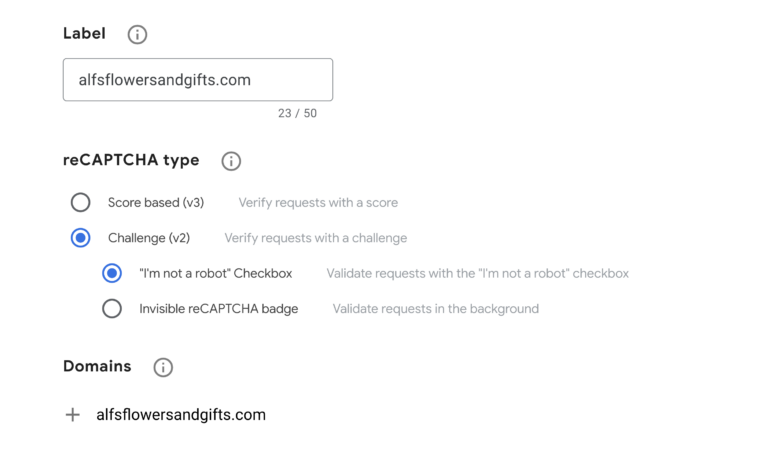
Retrieving and Adding Keys
Google will generate a Site Key and Secret Key. Copy these keys and paste them into their respective fields in AffiliateWP » Settings » Affiliates.
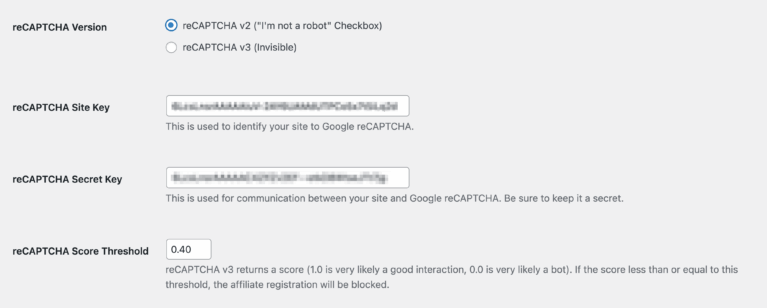
If you’re using reCAPTCHA v3, the Score Threshold setting determines how strictly reCAPTCHA filters suspicious behavior.
- A lower threshold (e.g., 0.3) is less strict, allowing more registrations but potentially letting some spam through.
- A higher threshold (e.g., 0.7) is stricter, reducing spam but potentially blocking legitimate users.
Adjust this setting as needed, then click Save Changes to apply.
Adding reCAPTCHA to the Login Form
After selecting reCAPTCHA, you’ll also see a checkbox labeled Add CAPTCHA to Affiliate Login form.

Select this option if you’d like to apply reCAPTCHA protection to the login form as well. This helps block automated login attempts and strengthens overall security.
Don’t forget to save your changes after enabling this option.
Testing reCAPTCHA
After completing setup, it’s important to confirm that reCAPTCHA is working correctly on both the registration and login forms.
Testing the Registration Form
If you’re using reCAPTCHA v2, go to your affiliate registration page and verify that the “I’m not a robot” checkbox appears. Complete the form and submit a test registration to ensure it works as expected.
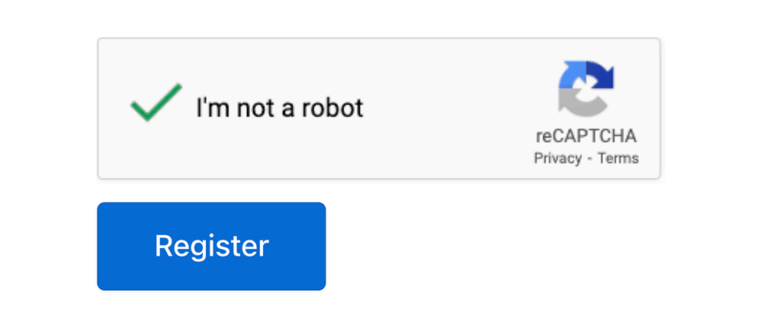
If you’re using reCAPTCHA v3, visit the registration page and check that the reCAPTCHA badge appears in the bottom-right corner of the page. Submit a test registration to confirm that submissions are processed without errors. No user interaction is required with v3.

Testing the Login Form
If you enabled the Add CAPTCHA to Affiliate Login form option in your settings, reCAPTCHA will also apply to the affiliate login page.
With reCAPTCHA v2, the login form will display the “I’m not a robot” checkbox. You may be prompted to complete an image challenge if Google suspects suspicious behavior.
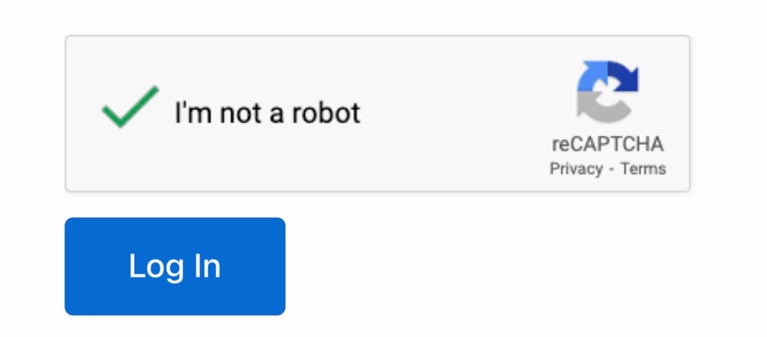
With reCAPTCHA v3, there will be no visual CAPTCHA on the login form. Instead, reCAPTCHA will evaluate the login attempt silently using your configured Score Threshold.

If everything looks and functions correctly, your registration forms are now protected.
Frequently Asked Questions
Can I use reCAPTCHA for other forms on my WordPress site?
The reCAPTCHA integration in AffiliateWP is specifically designed for affiliate registration forms. To protect other forms, such as contact forms or comment sections, you’ll need to use a WordPress plugin that supports global reCAPTCHA integration, like WPForms or Contact Form 7.
Does reCAPTCHA v3 block all suspicious users?
No, reCAPTCHA v3 provides a spam score based on user behavior. It’s up to your settings (Score Threshold) to decide how strict the filtering is. Lower thresholds are more permissive, while higher thresholds are stricter, potentially blocking more users, including some legitimate ones.
Is reCAPTCHA compatible with caching plugins?
Yes, reCAPTCHA is generally compatible with caching plugins. However, ensure that dynamic pages, like your affiliate registration form, are excluded from caching to avoid conflicts.
How do I know reCAPTCHA is working?
You can test reCAPTCHA by visiting your registration form as a new user. For v2, ensure the “I’m not a robot” checkbox or image challenge appears. For v3, check for the badge in the bottom-right corner of the page and ensure registrations are processed correctly.
Will enabling reCAPTCHA impact my affiliate conversions?
When configured correctly, reCAPTCHA minimizes spam without negatively affecting conversions. Using v3 ensures a seamless experience for legitimate users, as they won’t need to interact with a CAPTCHA.
What happens if I switch from reCAPTCHA v2 to v3 (or vice versa)?
If you switch reCAPTCHA types, you must update the Site Key and Secret Key in AffiliateWP settings. Testing your registration form after the switch ensures the new setup works correctly.
What should I do if reCAPTCHA is not displaying on my form?
If reCAPTCHA isn’t appearing:
- Check for JavaScript errors or conflicts with other plugins or themes.
- Ensure the correct Site Key and Secret Key are added to AffiliateWP settings.
- Verify your registration form is active and using the correct page.
That’s it! Google reCAPTCHA is a powerful tool for safeguarding your affiliate registration forms against spam and fraud. Whether you choose the interactive protection of v2 or the seamless background monitoring of v3, enabling reCAPTCHA ensures a smoother, more secure experience for legitimate users.